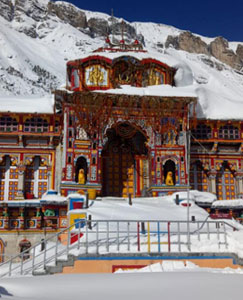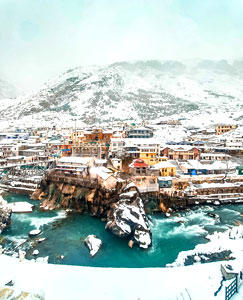About Badrinath
The picturesque town of Badrinath is where divinity meets with the serenity of nature. Located in the Chamoli district in Uttarakhand at the height of 3,133 meters, the pre-eminent abode of Lord Vishnu is one of the holiest of the holy shrines of Char Dham pilgrimage in India. Other Char Dham sites include Dwarka, Puri and Rameswaram.
Situated between Nar and Narayan peaks, the pious land of Vishnu also belongs to the Chota Char Dham Yatra in Uttarakhand. Starting with Yamunotri, Gangotri and Kedarnath, Badrinath is the last and most celebrated stop in the pilgrimage tour of Garhwal Himalayas. Badrinath Dham is easily accessible by motorable roads and the Badrinath temple can be reached by walking along an easy trek. Around 3 km from Badrinath is the village of Mana, which is one of the last villages before the boundary of India ends and that of Tibet begins. The peak of Neelkanth stands strong spreading its mighty aura for all pilgrims and travellers alike.
Badrinath is a land of myriad legends, each one only adding to the glory of this place. Along with these legends, the snowy mountain peaks, gracefully flowing Alaknanda River and incredible landscapes create the perfect background to facilitate a spiritual connection.
Badrinath Temple
Ancient texts hold this abode of Lord Vishnu at a very high esteem, stating - "there are many spots of pilgrimage in the heaven, earth and the world, but there has been none equal to Badri, nor shall there be." At the height of 3,133 meters, it stands proud with its rich past along the banks of Alaknanda River. Regarded as the most important temple of Vishnu, the Badrinath shrine is said to be established by Adi Shankaracharya. He found the Saligram idol of Lord Badri immersed in the waters of Alaknanda and installed it in a cave near the Tapt Kund.
It was in the 16th century that a Garhwal King got a temple erected to house the statue of the God. The present structure is the result of plenty of restorations the temple has undergone due to damages caused by avalanches and earthquakes. Lord Vishnu can be worshipped in a black stone idol sitting in a meditative pose surrounded by idols of other gods like Nar, Narayana, Narad, Ganesha, Garud and Kuber. In the winter season, the idol of Lord Badri is shifted to Yogadhyan Badri in Pandukeshwar (Chamoli district).
Best Time to Visit
Badrinath has a chilly and cold climate almost throughout the year. The peak season to visit this place is between May to June and September to October. With the onset of the Monsoon season, Badrinath witnesses heavy rainfall and a drop in temperature. Winters here are extremely cold due to heavy snowfall. Mostly in winters, the temperatures touch the sub-zero level, making the climate too frosty. Hence the summer season is the ideal time to visit this place.













Booking Form